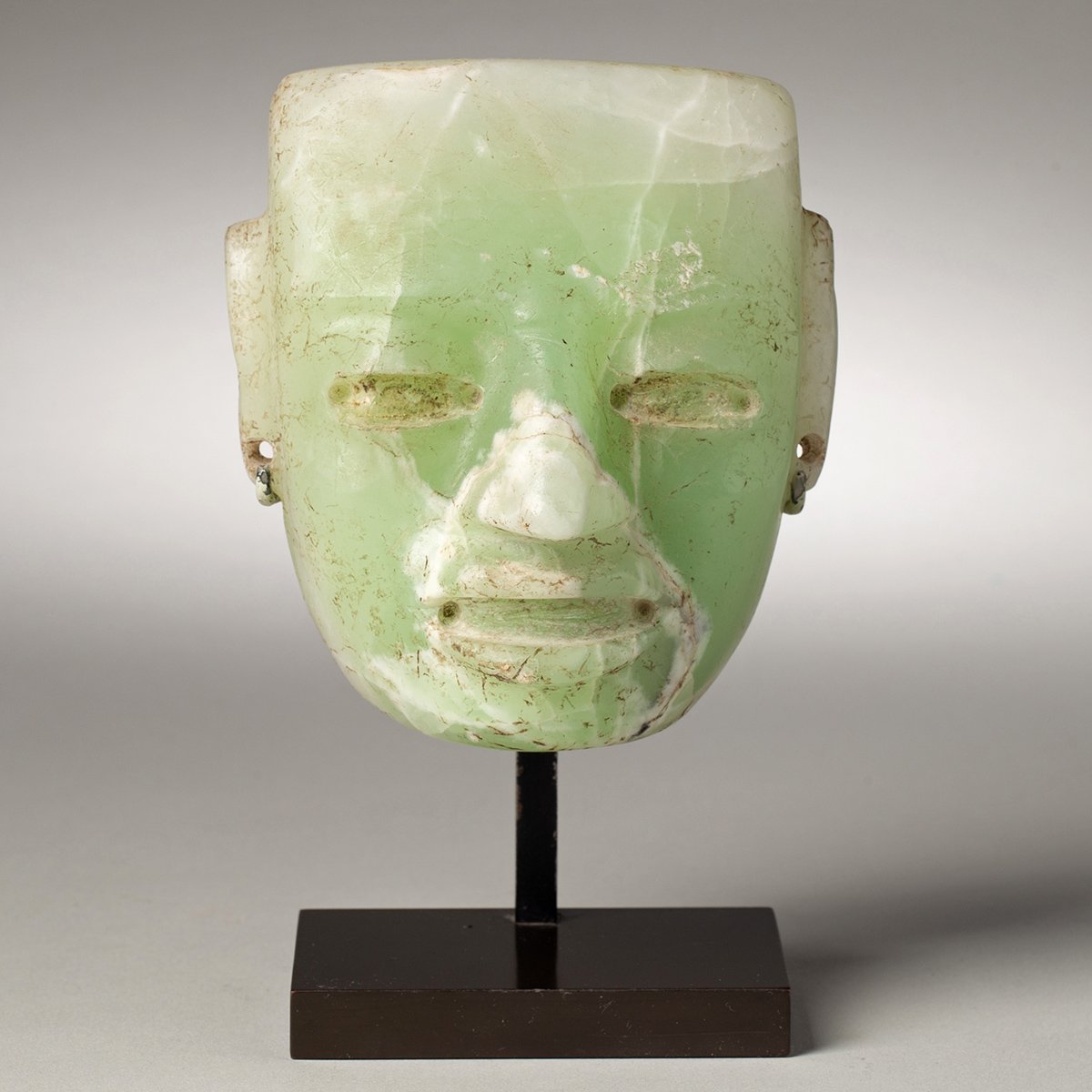 Image 1 of 6
Image 1 of 6

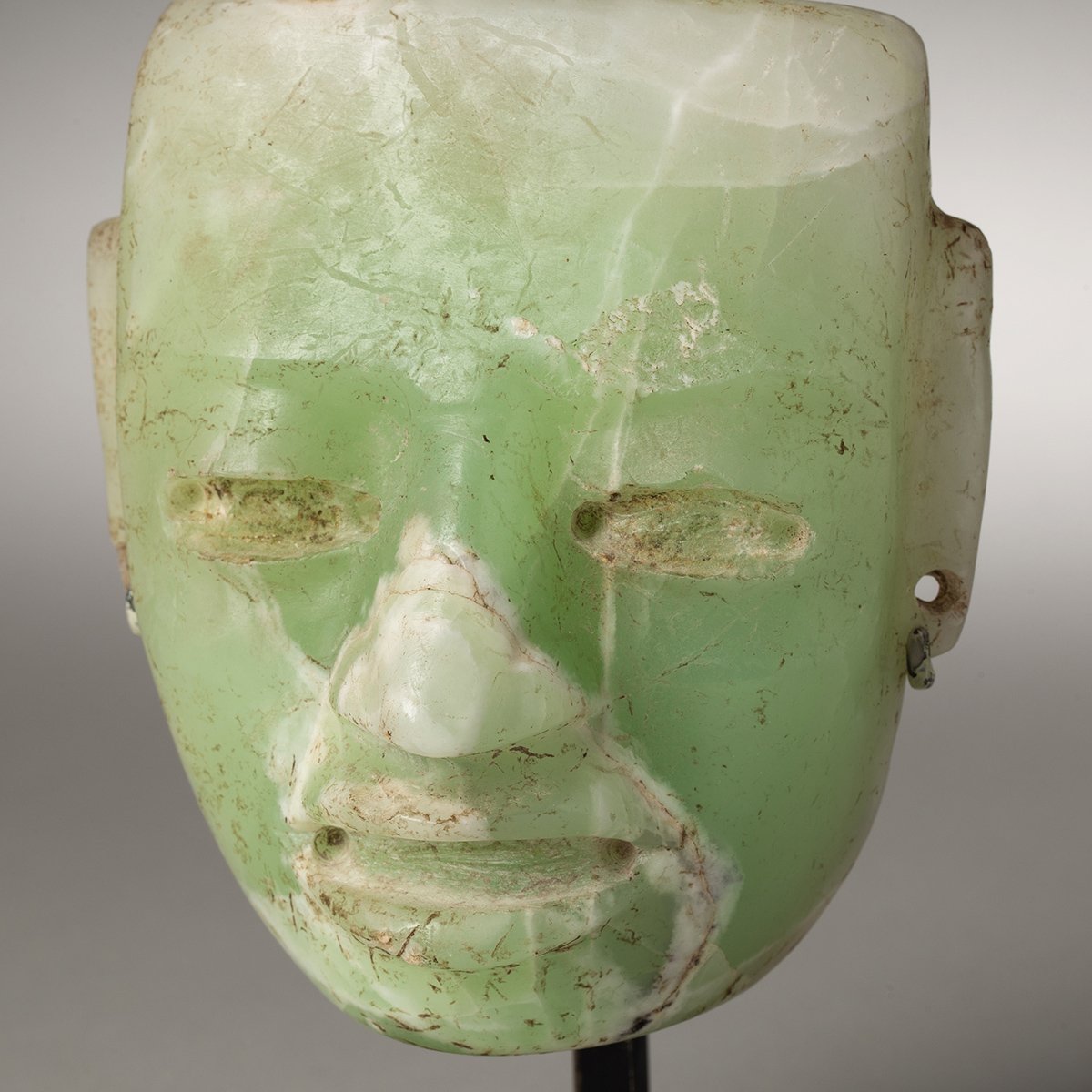 Image 2 of 6
Image 2 of 6

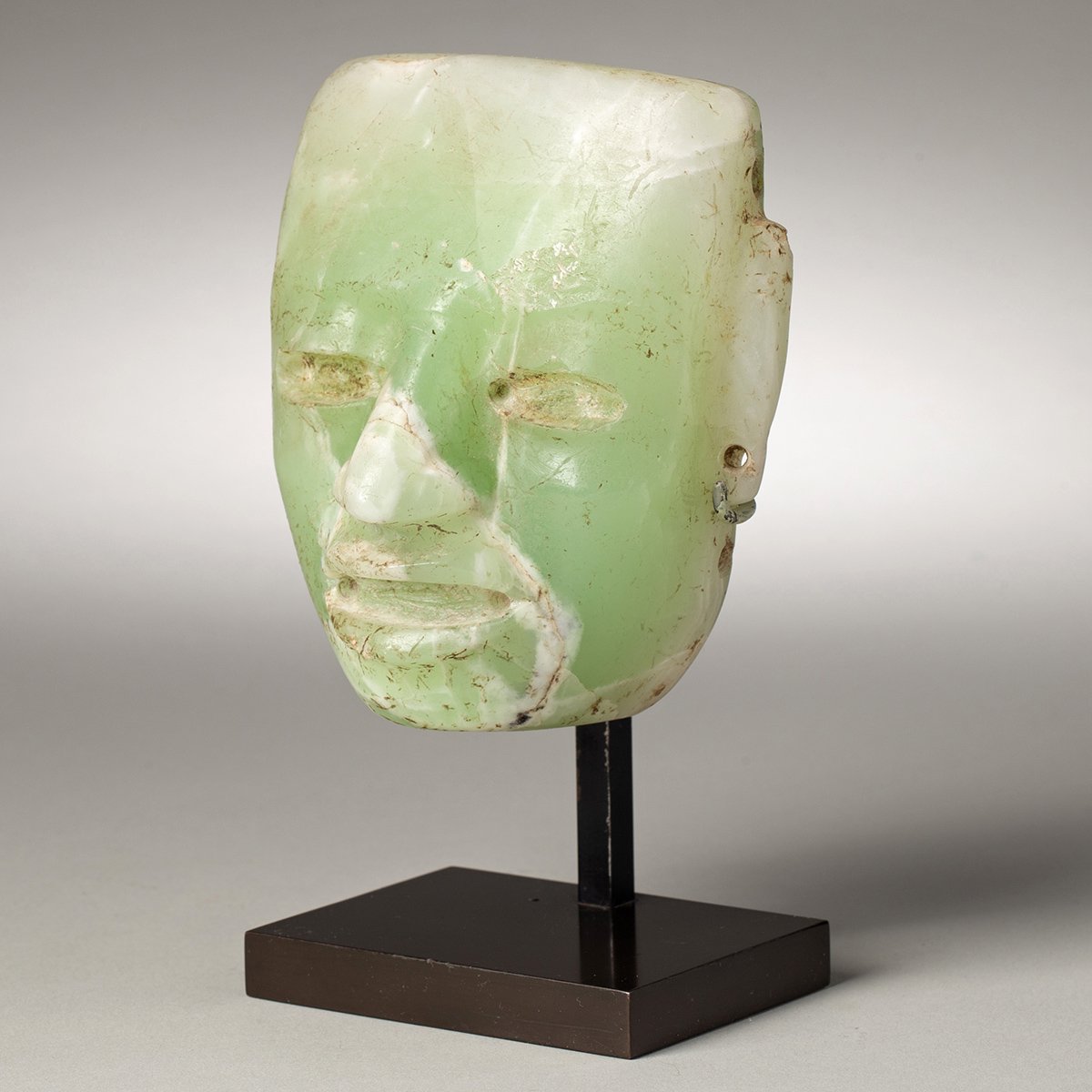 Image 3 of 6
Image 3 of 6

 Image 4 of 6
Image 4 of 6

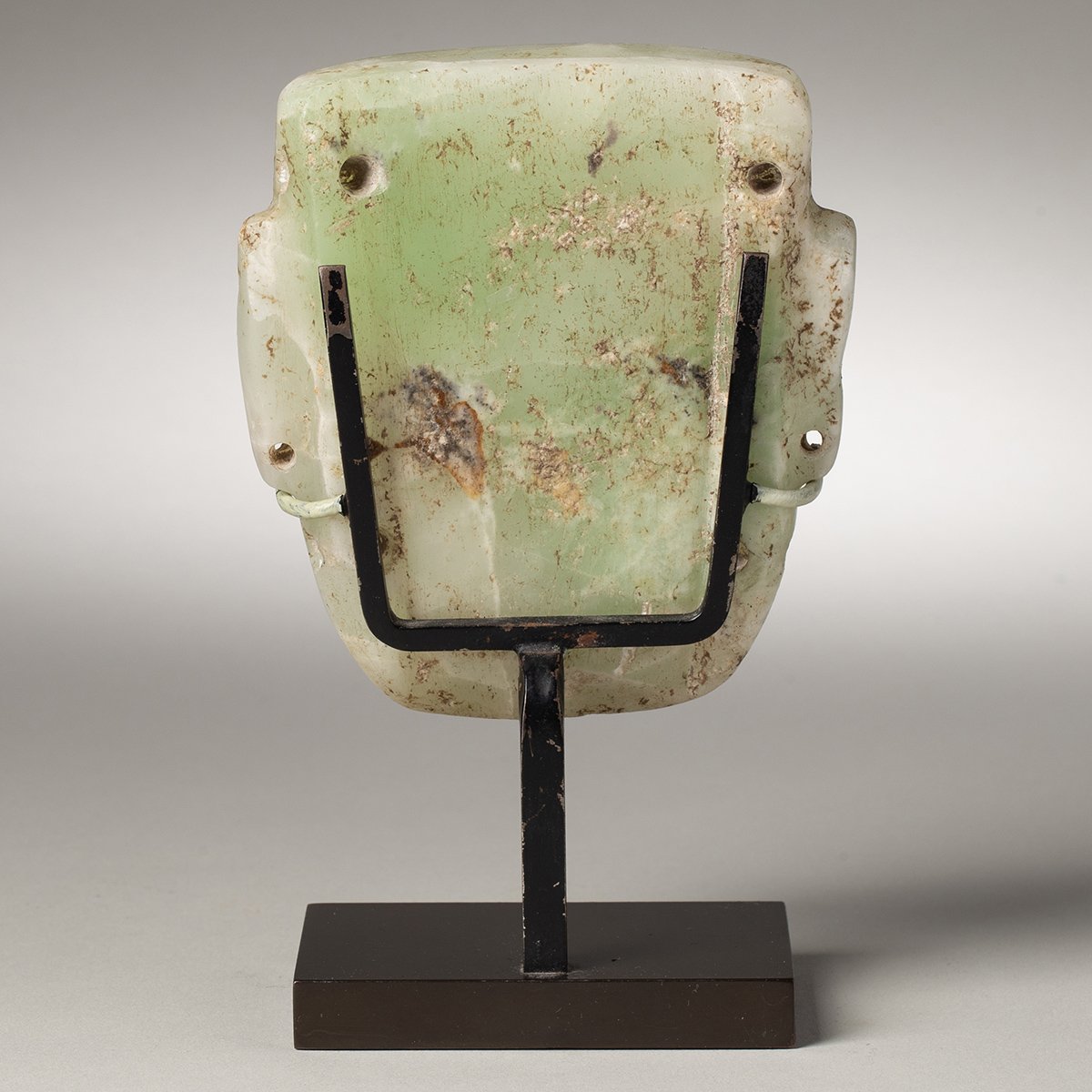 Image 5 of 6
Image 5 of 6

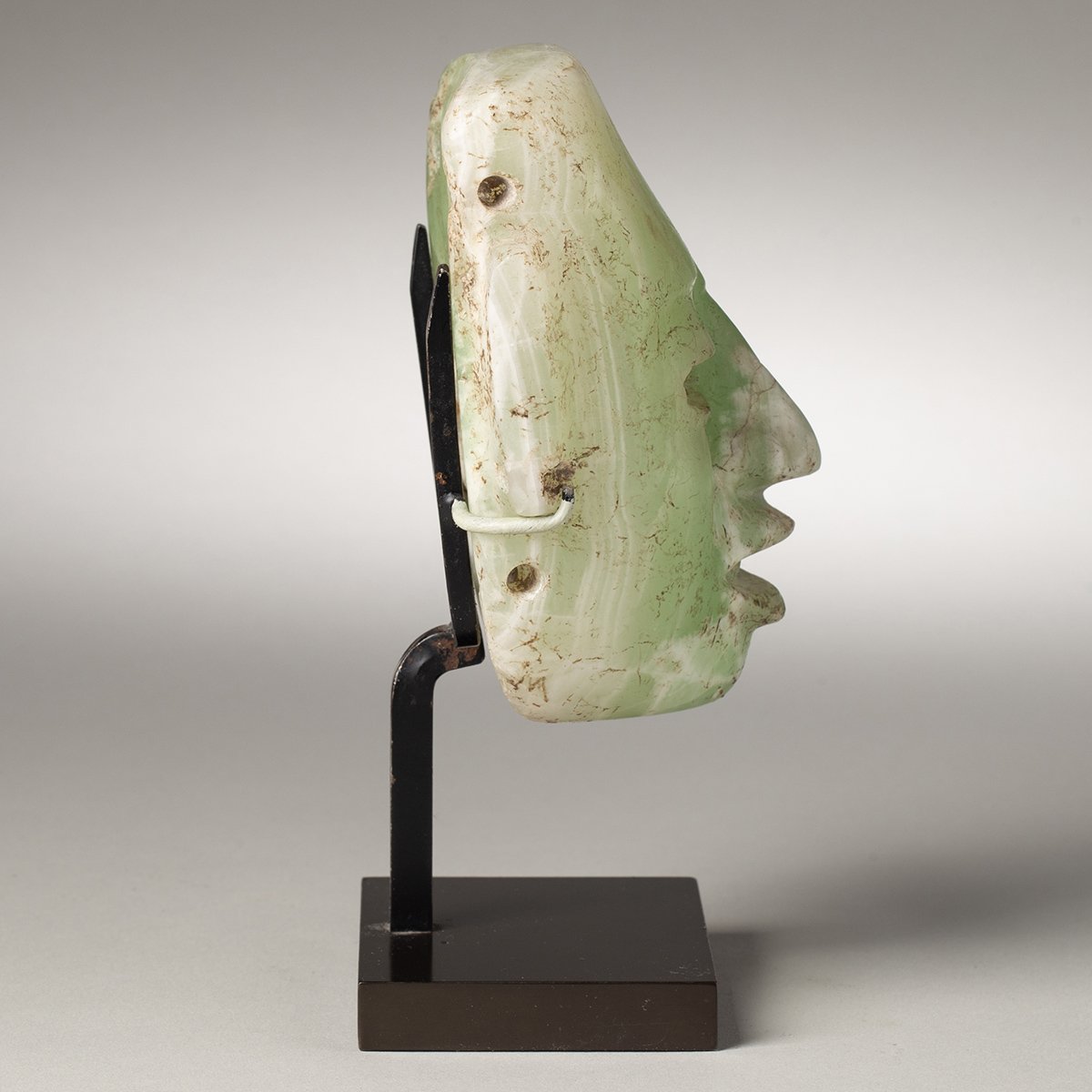 Image 6 of 6
Image 6 of 6







Important Teotihuacan Mask
Green Fluorite
600 - 900 AD
Height 4 3/4"
Provenance: Ron Messick, Santa Fe, NM, 1994
Private collection Connecticut
Freida Kahlo, Mexico City
Three-dimensional stone masks depicting a conventionalized human-like face are abundant in the sculptural style associated with the great Central Mexican city of Teotihuacan. With its geometrically rendered horizontal brow, triangular nose, and oval mouth and eyes, this mask depicts an idealized facial type that seems to function as a symbol, rather than a portrait, similar to other standardized motifs present in the art of Teotihuacan.
Perforations at the sides on the reverse suggest that it was intended to be attached to another object, but given the weight of the stone and the lack of holes for the eyes and mouth, these masks were probably not worn by living people. Instead, they may have been attached to larger, perishable sculptures of human or deity figures or mounted on or placed within mummy or deity bundles. They may represent a local version of the Mesoamerican maize deity, the stony faces as metaphors for maize seeds to be planted and reborn as tender sprouts.
Root marks with substantial environmental deposits. Rare!
cf.
Berrin, Kathleen, and Esther Pasztory. Teotihuacan: Art from the City of the Gods. The Fine Arts Museums of San Francisco, 1993.
Carballo, David M., Kenneth G. Hirth, and Barbara Arroyo. Teotihuacan: The World Beyond the City. Dumbarton Oaks, 2020.
Cowgill, George L. State and Society at Teotihuacan. Annual Review of Anthropology, Vol. 26, pp. 129-161, 1997.
Headrick, Annabeth. The Street of the Dead…It Really Was: Mortuary Bundles at Teotihuacan. Ancient Mesoamerica, Vol. 10, No. 1, pp. 69-85, 1999.
Headrick, Annabeth. The Teotihuacan Trinity: The Sociopolitical Structure of an Ancient Mesoamerican City. University of Texas Press, 2007.
López Luján, Leonardo, Laura Filloy Nadal, Barbara W. Fash, William L. Fash, and Pilar Hernández. The Destruction of Images in Teotihuacan: Anthropomorphic Sculpture, Elite Cults, and the End of a Civilization. RES: Anthropology and Aesthetics, no. 49/50, pp. 12-39, Spring-Autumn, 2006.
Manzanilla, Linda R. Cooperation and tensions in multiethnic corporate societies using Teotihuacan, Central Mexico, as a case study. Proceedings of the National Academy of Sciences of the United States of America Vol. 112, No. 30, pp. 9210-9215, 2015.
Murakami, Tatsuya. Entangled Political Strategies: Rulership, Bureaucracy, and Intermediate Elites at Teotihuacan. In Sarah Kurnick and Joanne Baron, eds., Political Strategies in Pre-Columbian Mesoamerica, pp. 153-179. University Press of Colorado, 2016.
Pasztory, Esther. Teotihuacan: An Experiment in Living. University of Oklahoma Press, 1997.
Green Fluorite
600 - 900 AD
Height 4 3/4"
Provenance: Ron Messick, Santa Fe, NM, 1994
Private collection Connecticut
Freida Kahlo, Mexico City
Three-dimensional stone masks depicting a conventionalized human-like face are abundant in the sculptural style associated with the great Central Mexican city of Teotihuacan. With its geometrically rendered horizontal brow, triangular nose, and oval mouth and eyes, this mask depicts an idealized facial type that seems to function as a symbol, rather than a portrait, similar to other standardized motifs present in the art of Teotihuacan.
Perforations at the sides on the reverse suggest that it was intended to be attached to another object, but given the weight of the stone and the lack of holes for the eyes and mouth, these masks were probably not worn by living people. Instead, they may have been attached to larger, perishable sculptures of human or deity figures or mounted on or placed within mummy or deity bundles. They may represent a local version of the Mesoamerican maize deity, the stony faces as metaphors for maize seeds to be planted and reborn as tender sprouts.
Root marks with substantial environmental deposits. Rare!
cf.
Berrin, Kathleen, and Esther Pasztory. Teotihuacan: Art from the City of the Gods. The Fine Arts Museums of San Francisco, 1993.
Carballo, David M., Kenneth G. Hirth, and Barbara Arroyo. Teotihuacan: The World Beyond the City. Dumbarton Oaks, 2020.
Cowgill, George L. State and Society at Teotihuacan. Annual Review of Anthropology, Vol. 26, pp. 129-161, 1997.
Headrick, Annabeth. The Street of the Dead…It Really Was: Mortuary Bundles at Teotihuacan. Ancient Mesoamerica, Vol. 10, No. 1, pp. 69-85, 1999.
Headrick, Annabeth. The Teotihuacan Trinity: The Sociopolitical Structure of an Ancient Mesoamerican City. University of Texas Press, 2007.
López Luján, Leonardo, Laura Filloy Nadal, Barbara W. Fash, William L. Fash, and Pilar Hernández. The Destruction of Images in Teotihuacan: Anthropomorphic Sculpture, Elite Cults, and the End of a Civilization. RES: Anthropology and Aesthetics, no. 49/50, pp. 12-39, Spring-Autumn, 2006.
Manzanilla, Linda R. Cooperation and tensions in multiethnic corporate societies using Teotihuacan, Central Mexico, as a case study. Proceedings of the National Academy of Sciences of the United States of America Vol. 112, No. 30, pp. 9210-9215, 2015.
Murakami, Tatsuya. Entangled Political Strategies: Rulership, Bureaucracy, and Intermediate Elites at Teotihuacan. In Sarah Kurnick and Joanne Baron, eds., Political Strategies in Pre-Columbian Mesoamerica, pp. 153-179. University Press of Colorado, 2016.
Pasztory, Esther. Teotihuacan: An Experiment in Living. University of Oklahoma Press, 1997.
Green Fluorite
600 - 900 AD
Height 4 3/4"
Provenance: Ron Messick, Santa Fe, NM, 1994
Private collection Connecticut
Freida Kahlo, Mexico City
Three-dimensional stone masks depicting a conventionalized human-like face are abundant in the sculptural style associated with the great Central Mexican city of Teotihuacan. With its geometrically rendered horizontal brow, triangular nose, and oval mouth and eyes, this mask depicts an idealized facial type that seems to function as a symbol, rather than a portrait, similar to other standardized motifs present in the art of Teotihuacan.
Perforations at the sides on the reverse suggest that it was intended to be attached to another object, but given the weight of the stone and the lack of holes for the eyes and mouth, these masks were probably not worn by living people. Instead, they may have been attached to larger, perishable sculptures of human or deity figures or mounted on or placed within mummy or deity bundles. They may represent a local version of the Mesoamerican maize deity, the stony faces as metaphors for maize seeds to be planted and reborn as tender sprouts.
Root marks with substantial environmental deposits. Rare!
cf.
Berrin, Kathleen, and Esther Pasztory. Teotihuacan: Art from the City of the Gods. The Fine Arts Museums of San Francisco, 1993.
Carballo, David M., Kenneth G. Hirth, and Barbara Arroyo. Teotihuacan: The World Beyond the City. Dumbarton Oaks, 2020.
Cowgill, George L. State and Society at Teotihuacan. Annual Review of Anthropology, Vol. 26, pp. 129-161, 1997.
Headrick, Annabeth. The Street of the Dead…It Really Was: Mortuary Bundles at Teotihuacan. Ancient Mesoamerica, Vol. 10, No. 1, pp. 69-85, 1999.
Headrick, Annabeth. The Teotihuacan Trinity: The Sociopolitical Structure of an Ancient Mesoamerican City. University of Texas Press, 2007.
López Luján, Leonardo, Laura Filloy Nadal, Barbara W. Fash, William L. Fash, and Pilar Hernández. The Destruction of Images in Teotihuacan: Anthropomorphic Sculpture, Elite Cults, and the End of a Civilization. RES: Anthropology and Aesthetics, no. 49/50, pp. 12-39, Spring-Autumn, 2006.
Manzanilla, Linda R. Cooperation and tensions in multiethnic corporate societies using Teotihuacan, Central Mexico, as a case study. Proceedings of the National Academy of Sciences of the United States of America Vol. 112, No. 30, pp. 9210-9215, 2015.
Murakami, Tatsuya. Entangled Political Strategies: Rulership, Bureaucracy, and Intermediate Elites at Teotihuacan. In Sarah Kurnick and Joanne Baron, eds., Political Strategies in Pre-Columbian Mesoamerica, pp. 153-179. University Press of Colorado, 2016.
Pasztory, Esther. Teotihuacan: An Experiment in Living. University of Oklahoma Press, 1997.

